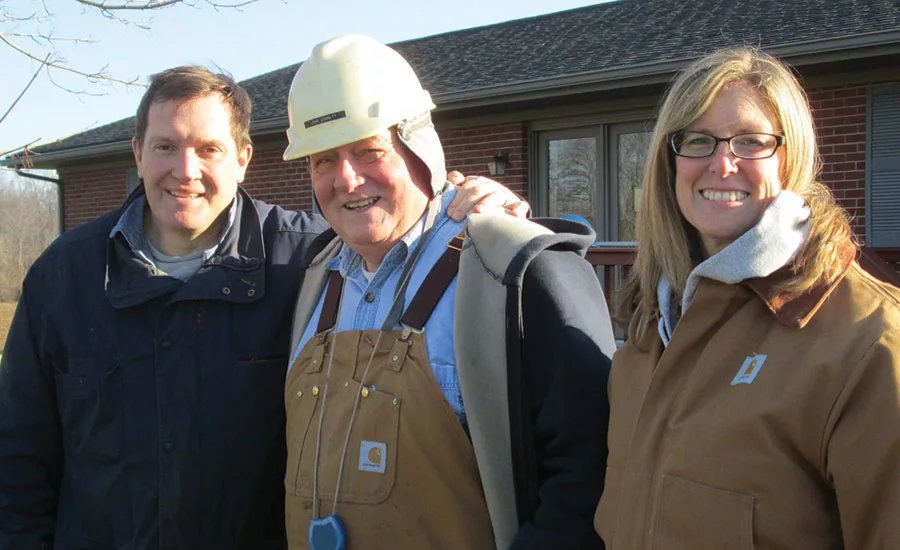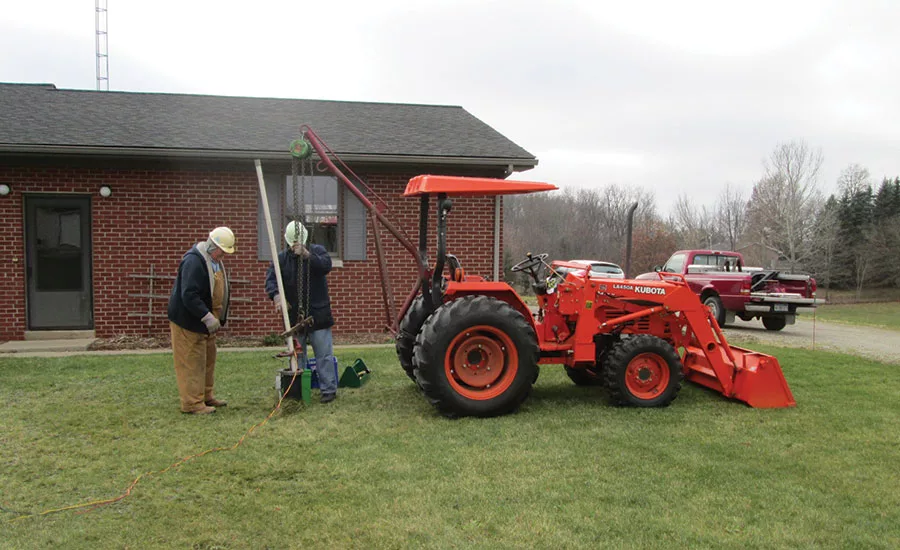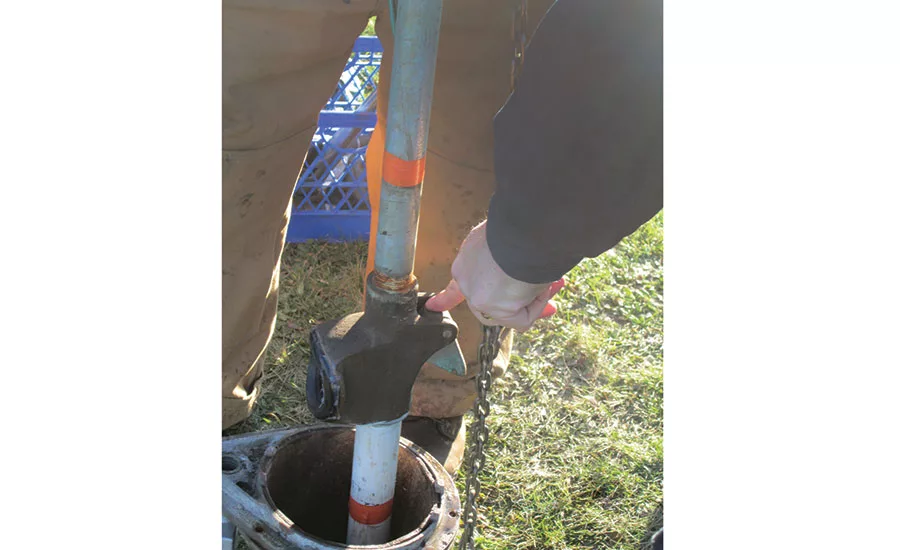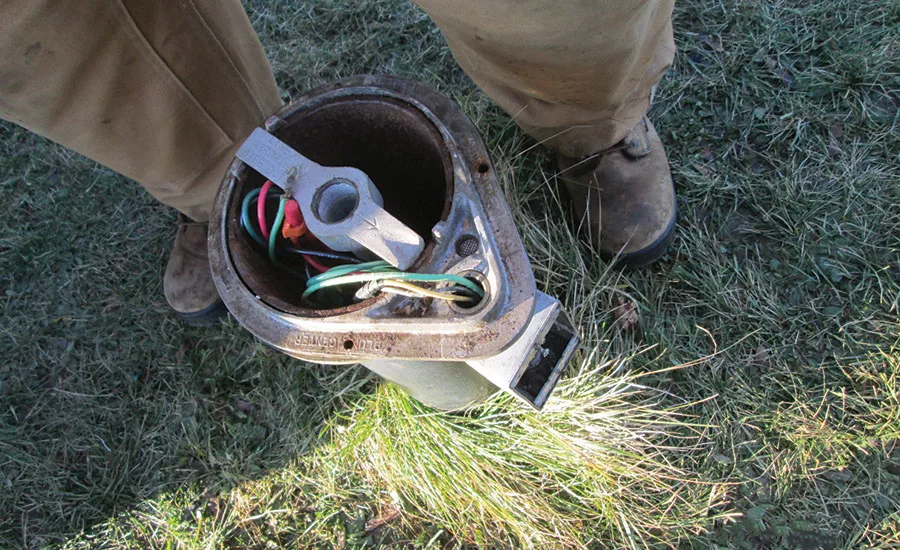Pulling a Submersible Pump the Old Way - By Hand

Columnist John Schmitt, center, with son-in-law Dennis and daughter Loretta. Source: John Schmitt photos

Columnist John Schmitt, left, with son-in-law Dennis use a tractor rigged up with a lifter Schmitt’s dad made in the 1930s to pull pipe.

In this photo, you can see the original gasket from the pump’s 1990 installation, which was still holding a seal.

A weather-proof electrical box sits on the outside of the ready-to-be-capped well. Source: John Schmitt
Readers, you will have to forgive me, for I am going to take a short detour from my series of columns about clamp-on pitlesses. I recently had occasion to pull a pump that I had installed years ago and, not having a pump hoist available, did it the way we used to do it. Not being a young man anymore, I recruited a crew to help and the two people I got were my daughter Loretta and her husband Dennis. Now Loretta played softball in high school, and as the mother of three adult children still plays ladies’ ice hockey. Her husband, Dennis, was a center and linebacker on his high school football team and is built like most of these fellows are. He is also black belt in karate and has a strong upper body. Both of them have masters in business administration and neither of them has ever worked a day in the groundwater industry. They were, however, eager to see what was down inside that well. A picture of our crew is enclosed and you can see that I have the ear flaps down on my hard hat’s liner. It was a cool day but not bitter cold.
We pulled a 1-horsepower submersible hung on 100 feet of 1.25-inch schedule 80 drop pipe. This was in a 6-inch steel cased well of about 180 feet deep, finished in coarse gravel with 7 feet of stainless steel screen. This is an excellent well and, from indications on the drop pipe, the static level only draws down about 15 inches — yes, inches, not feet, when being pumped at approximately 25 gpm. This well was drilled in 1989 and gets a lot of use as the home it serves has an open-loop geothermal heat pump. The well was drilled when the house was new. The homeowner noticed some strong thumping noises on starting and stopping of the pump we pulled. That is usually a sign of check valve trouble, which proved to be right. In Michigan, water well codes do not allow a check valve outside the well casing, so a valve at the tank is illegal. As the pump we pulled was over 15 years old, I advised that we consider a new pump to replace the older unit although it was still pumping at good capacity.
In Michigan and much of the Midwest, we are blessed with abundant groundwater. The average well depth in my home county is probably 125 feet. Most wells drilled in this area will produce far more water than a household needs. We estimated that the well we pulled this pump on could produce over 300 gpm when it was new — just a nice house well. Now I know some of you readers operate in areas where the wells are really deep, and many of you set long strings of steel drop pipe or pump column; I know you really can’t pull one of these up by hand, but in southern Michigan we do have that advantage. On this job a pump hoist was unavailable, but we did have use of the well owner’s utility tractor with a gin pole or boom that attaches to the three-point hitch. We hooked a small chain hoist to this boom and went to pulling. Another picture included shows Dennis pulling the chains and I am pointing at something and you can see the utility tractor. To grab the pipe we used a lifter made by my father in the 1930s — and it still works very well on both steel and plastic pipe. We got the drop pipe and pump out without problem, and on a later inspection found the lower check valve near total failure. This was probably from water rushing through it rather quickly. I have never found the built-in checks in the top of most submersibles to be very durable, and I have sold several brands of pumps over the years. At least one knowledgeable person at a local supply house says they have found the same thing to be true. I usually add an external check right above the pump, but even those are not all that great.
We installed a new pump and a new check valve, but used the old drop as it was in like-new condition. With the empty pipe on the way back down, Dennis was able to just slide the sections over his shoulder and we used our pipe lifter as a safety. Loretta expressed an interest in using the pipe wrenches and, on checking her work, I found the joints to be plenty tight. I guess it is true women who can do a lot of the jobs we men do.
When installing a replacement pump, I like to test-pump them “over the top.” That is from the top of the drop pipe and not through the pitless and the pressure tank. We test-pumped this unit and were getting a little over 24 gpm at 30 psi. When test pumping like this, we usually find some cloudy water coming out and after a while it will clear up, so we will be pumping clear, clean water into the distribution system. We are then ready to install the pitless and reconnect the system.
Another picture shows the body of the pitless adapter on this installation with a gasket coated with Vaseline — I don’t know if this is a necessity or not, but I have always done it. That is to coat the parts on any pitless — and it works for me. This incidentally is the original gasket from when the first pump was installed on this well in 1990, and it still holds pressure 100-percent perfect. This pitless body is made of brass and you can probably tell the hanger pipe is galvanized steel. Some fellows use schedule 80 PVC for the hanger pipe, and that works too. You can see Dennis’ finger holding the part I call the flipper, which squeezes the gasket when tightened against the casing to make a watertight joint. If we were in an area where the water is really corrosive and we were using steel casing, we probably wouldn’t want to use this type of pitless adapter. Not incidentally, if someone is holding the flipper partially tight they need to be very, very careful they don’t get their finger caught because, if they do, this can have disastrous results.
The last picture shows the well ready to be capped and has a clear view of the so called bridge that holds the weight of the pump and drop pipe. This cap has some ears on it so alignment with the hole in the casing is pretty well assured. This picture also shows a weather proof electrical box that is installed just below the cap on the conduit that brings wires from the house. When this unit was installed new, the county electrical inspector said that the area inside the casing was not an approved splice box and required this box on the outside. As you can see, we made the connections inside the casing. I think the National Electrical Code, or NEC, is silent on this subject and was told that this was an inspectors “vest pocket rule,” but he was the inspector and that is the way we hooked them up back then.
Well now you young fellows have some idea how we did pump service years ago. Actually, in those days, we were pulling pumps from wells that ended in well pits and well houses, not from pitless adapters. Could we have done this job faster with a pump hoist? The answer is “yes,” and I could have done it alone. Another way would be to use one of these small electrical “pump pullers” that are available now, but you would probably still need a helper to handle that pipe up over your head. We were able to transport everything we needed to do this job in a mini pickup, except for the tractor. Without the tractor, we could have used a tripod and that would have worked too. Some owners in our area won’t let you drive a pump hoist truck over their lawn or a flower bed that restricts access to their well; this old-fashioned method avoids that.
Next time I will get back to pitlesses and a really unique type, the pitless adapter tank. In mid-January in Michigan we have almost no snow, but the temperatures are in the single digits and with the wind chill way below zero — not nice weather to pull pumps in.
Looking for a reprint of this article?
From high-res PDFs to custom plaques, order your copy today!


